The chess world is finally warming up again after the Pandemic Year. I feel a little bit guilty not writing about the 2020-21 Candidates Tournament, the longest tournament in history (?), which is nearing a conclusion more than a year after it began. Ian Nepomniachtchi seems to be on the verge of winning and earning the right to challenge Magnus Carlsen for the world championship.
But you can read about these exciting events in many places online. For now, I’ll continue my once-a-week chess memoir, which has reached the year 2002. I’ve been so much enjoying the chance to go back and look at my ups and downs in chess, so many of which I had forgotten. And I think that some of you are enjoying it too! I have a great game for you today.
I’ve written several times before about IM Emory Tate, even calling him my favorite opponent. Why? First of all, because he was a class act. He cared about the game more than he cared about ratings or prizes, and he was known as one of America’s foremost attacking players. He was a chess gladiator. It is so fitting that he died at the chessboard, although it was stunning and tragic at the time.
Another reason that Emory Tate was my favorite opponent was that I always felt that I had hope against him. In five games against him, I scored one win, two draws and two losses, and I had good chances even in the games that I drew and lost. The game I’ll show you here, from the 2002 North American Open, was the epitome of missed chances. Though it was a very disappointing defeat to me, there is a great deal to be learned from it, as I’ll explain below.
By the way, 2002 was the year I started using the chess computer regularly, with Fritz 7 on my desktop. Generally speaking I still analyzed games in the old way, by hand, and then checked a few crucial spots with the computer. But in this game, I missed so many things in my non-computer-aided analysis that I basically had to tear up the hand-written analysis and save the computer printout instead. Interestingly, Fritz 17 (the program I have now) disagrees with Fritz 7 (the program I had then) on several details. That means I have to be even more cautious when I write, “The computer says…” It may be almost as confused as I am!
Emory Tate — Dana Mackenzie, 12/28/2002
1. e4 e5 2. Nf3 Nc6 3. c3 …
The Ponziani Opening is rarely seen at any level; I’m not sure what motivated Tate to play it in this game. Maybe he thought I would be unprepared? If so, he was a little bit unlucky that I actually have a prepared line against it. The normal book move is 3. … d5, which is supposed to equalize, but I like the plucky move:
3. … f5!?
The point of this is that after 4. d4 we have a Vienna Game reversed, where White’s extra move c3 does him no good at all. In fact, in the normal Vienna Game (1. e4 e5 2. Nc3 Nf5 3. f4 d5 4. fe Nxe4) Black is able to answer 5. Qf3 with 5. … Nc6. But in this game, with colors reversed, Tate won’t have the option of playing 6. Nc3.
4. d4 fe 5. Nxe5 Qf6 6. Ng4 …
A somewhat odd-looking move, but the point is that Emory doesn’t want to give me time to play … d5.
6. … Qg6 7. d5 Nd8
This is the kind of move you see a lower-rated player (me) make against a higher-rated player (Tate). I probably should have played more assertively with 7. … h5 8. dc hg 9. cb Bxg7 10. Bf4 O-O-O, which was suggested later by my friend Gjon Feinstein.
8. Be2 Nf7 9. O-O h5 10. Ne3 Nf6 11. c4 Bd6?!
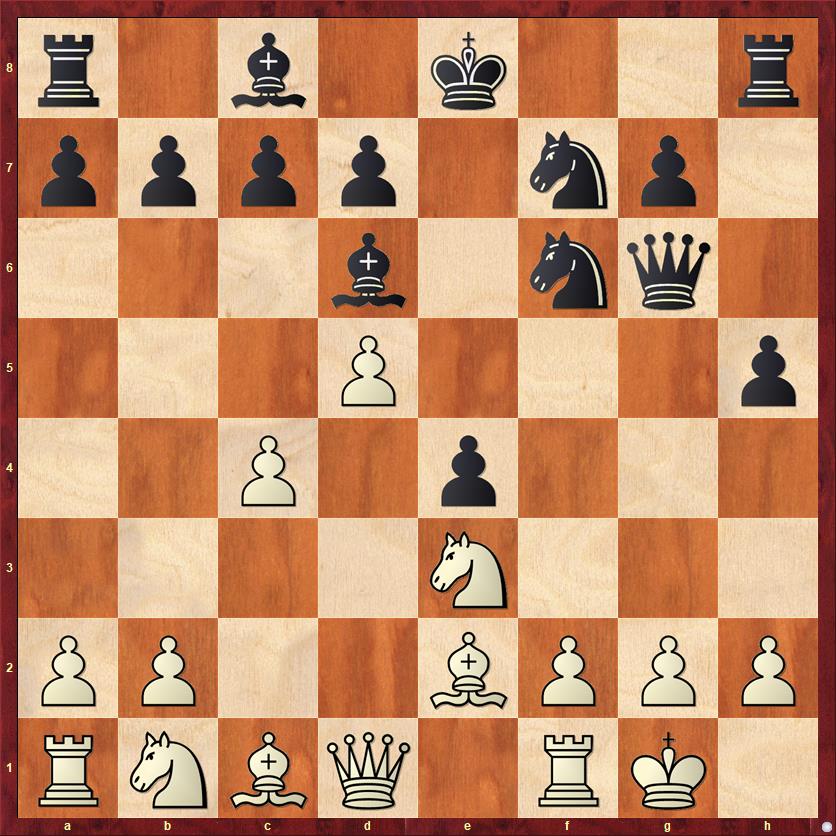
FEN: r1b1k2r/pppp1np1/3b1nq1/3P3p/2P1p3/4N3/PP2BPPP/RNBQ1RK1 w kq – 0 12
This game highlights several of my bad habits as a chess player. Here is one of them: a tendency to play weird moves just because they are weird. In what conceivable way is the bishop better posted on d6 than it would have been on c5? This move is especially unfriendly to my queen bishop, which will either have to develop on b7, where it does nothing, or wait for the king bishop to vacate d6.
12. Nc3 O-O 13. Rb1? …
The immediate 13. Nb5 puts the question to Black’s bishop, and underscores why 11. … Bd6 was a bad move. During the game I was planning to reply to 13. Nb5 with 13. … Be5? This just makes matters worse, assuming White finds the tricky answer 14. f4! ef 15. Bd3! Qg5 16. Rxf3!, which threatens 17. Nf5 trapping Black’s queen.
This is admittedly not an easy line to find. White has to find the unexpected 15. Bd3, which suddenly puts Black’s queen in hot water. However, this is an example of tactics following strategy. 13. Nb5 is strategically justified because Black’s bishop is misplaced and because all of Black’s pieces are kind of bunched up on the kingside. By slow-playing the position with 13. Rb1, Emory gives me the chance to untangle my pieces, after which Black’s initiative on the kingside becomes surprisingly strong.
15. Bd3 is just the first of many stellar “computer moves” that neither player saw in this game.
13. … Be5 14. Qc2 …
Tate continues to bide his time. It’s still worth considering 14. f4! Bxc3 15. bc d6 16. f5, chasing the queen back to h7.
14. … Bxc3 15. Qxc3 d6 16. b4 Ne5
White has done nothing to counteract the buildup of Black pieces on the kingside. Black by now stands a little bit better, in my opinion.
17. Kh1 Nfg4 18. Nxg4 Bxg4 19. Bxg4 hg!
I really like this move. If my 11th move was bad unconventional thinking, this is good unconventional thinking. Black’s kingside pawns may look ugly, but the open f-file and h-file are beautiful and that pawn on g4 is full of hidden menace, which you’re going to see shortly.
Many players are afraid of doubled pawns, especially doubled isolated pawns, which they see only as a weakness. But doubled pawns almost always come with an open file or semi-open file next door, and in many cases that is a more important consideration.
20. Be3 …
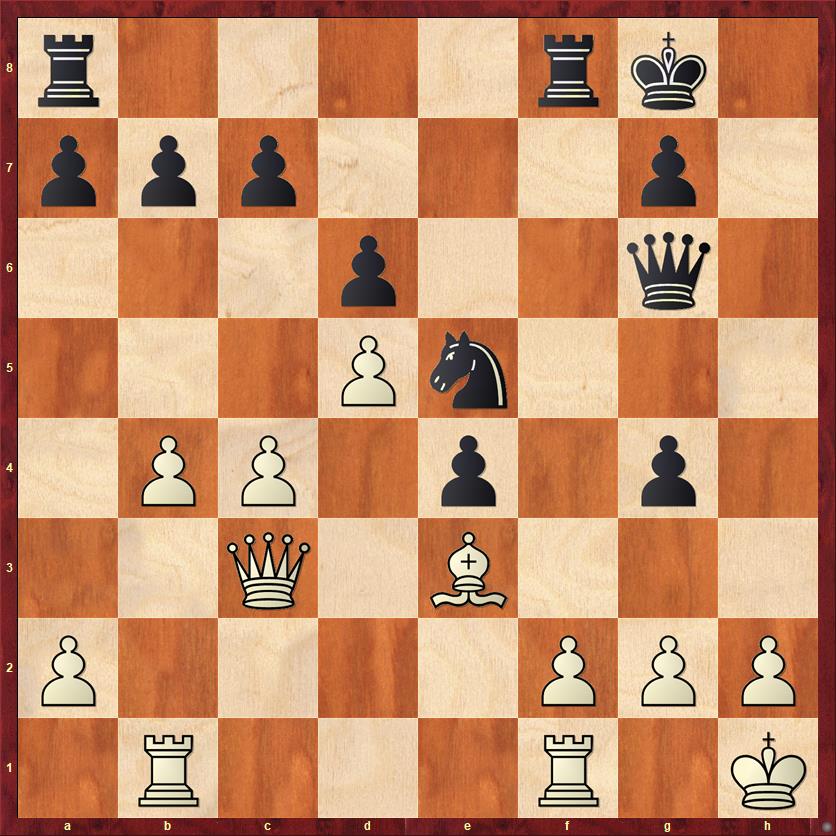
FEN: r4rk1/ppp3p1/3p2q1/3Pn3/1PP1p1p1/2Q1B3/P4PPP/1R3R1K b – – 0 20
Now I settled in for a long think.
20. … Rf5!
Putting two ideas in play: doubling rooks on the f-file, or lifting the rook over to the h-file, where it can form a battery with Black’s queen.
The computer will tell you that I played the best move. What it can’t tell you is that I took a ridiculously long time making this move, and started to sow the seeds of my own defeat. The problem was that I was obsessed by the possible piece sacrifice with … Nf3. This was a case of the Mike Splane Question gone wrong: I was convinced that I was going to sacrifice the knight and win with a checkmate on g2, or if he didn’t take the knight, I was going to win with a checkmate on h2. My single-minded obsession with this plan meant that I was blind to other plans. This is another one of my bad habits in chess, which Mike has pointed out on numerous occasions: tunnel vision. It is precisely in exciting, tactical positions like this one that you have to display the broadest vision possible. The best attacking players are the ones who can draw on the widest range of ideas.
So, anyway, I spent tons of time analyzing 20. … Qh5 but I just couldn’t find a win after 21. Bd4 Nf3 22. gf Rxf3 23. Qe1 Rh3 24. Qxe4 Rxh2+ 25. Kg1. And the computer says there isn’t one; the best Black can do is draw after 25. … Rf8 26. Rbe1 Qh3 27. Re3 Rf3 28. Qe8+ with a perpetual check. I didn’t really analyze this far over the board; I just got to move 25 and it did not seem like a position where I was winning.
But we shouldn’t be surprised that … Qh5 and … Nf3 doesn’t work yet. Black has not yet gotten all of his forces into play. Instead of putting all of our eggs in one basket, we should play flexibly and build our attack. And that’s what I eventually decided to do. Unfortunately, I was still psychologically committed to the piece sac on f3 and this blinded me to other possibilities. And with every passing move, I got deeper and deeper into time trouble as I continued trying to force the position into my pre-conceived idea, instead of the way the position wants to be played.
21. Rbd1 Raf8
The computer considers this a mistake. I cannot agree because it is consistent with the principles of attacking chess I have just mentioned: play flexible moves that give you lots of options, and invite all of your pieces to the party.
However, my move drops the computer evaluation of the position from about +2 pawns to about +1.25 pawns, which is a substantial drop. It’s worth asking why. The reason is that the computer prefers 21. … Qh7 and considers the attack on the h-file to be more dangerous than the attack on the f-file. For example, let’s look at what happens if White plays a reasonable answer like 22. Qc2. Black can now announce mate in six. It’s a lovely combination and a pattern that I think is worth remembering. Do you see it?
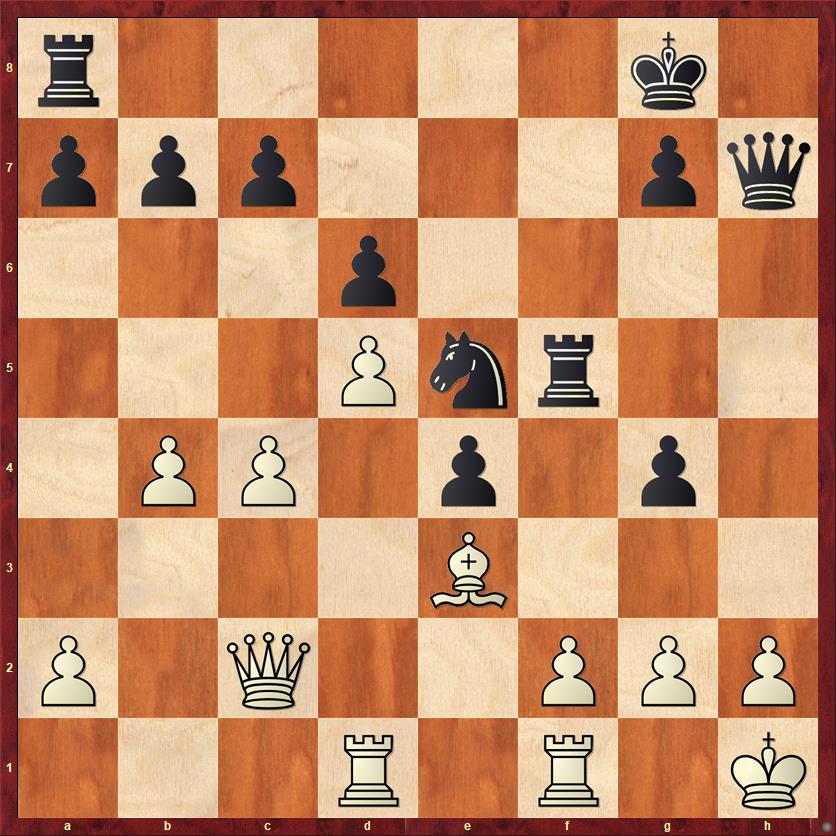
FEN: r5k1/ppp3pq/3p4/3Pnr2/1PP1p1p1/4B3/P1Q2PPP/3R1R1K b – – 0 22
The winning move — I’ve already given you a lot of hints — is 22. … Rh5! First, White can’t defend with 23. h3 because of 23. … Rxh3+ 24. gh Qxh3+ 25. Kg1 Nf3 mate. But the real question is, what happens after 22. … Rh5! 23. Bf4? It looks as if White has enough defenders for h2.
But looks can be deceiving! Black still wins with the striking rook sacrifice, 23. … Rxh2+!! 24. Bxh2 g3! 25. fg Ng4! What an amazing line! Black keeps hammering away at the h2 square, entombing the bishop there and finally overwhelming White’s defenses.
I don’t think I have ever seen this precise combination before, which surprises me because it has relatively few ingredients. You just need a knight on e5 or f6, a pawn on g4, and a rook-queen battery on the h-file, and you need White’s bishop on f4 or g3, apparently defending h2 but not defending it well enough. I feel certain that this combination must have occurred in master play, and I will be indebted to the first reader who finds me an example!
Nevertheless, as I said, my move 21. … Raf8 cannot be wrong. You will see that I get plenty more opportunities to win this game. The game continued
22. Bd4 …
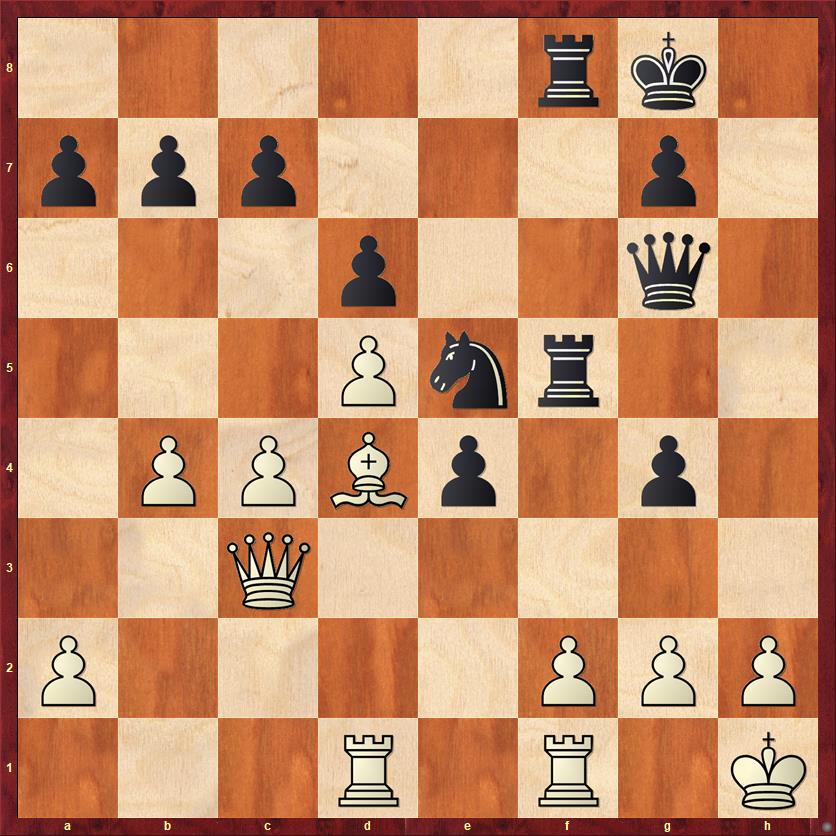
FEN: 5rk1/ppp3p1/3p2q1/3Pnr2/1PPBp1p1/2Q5/P4PPP/3R1R1K b – – 0 22
Now we get to a huge disagreement between Fritz 7 and Fritz 17 … and, amazingly, I tend to side with the older version of Fritz! I think that different readers might come to different conclusions, too. Black’s choice depends on a very fundamental question of what kind of advantage is better, a static material advantage or the advantage of the initiative.
When I got to this position using the 2002 version of Fritz, I was flabbergasted to see its recommendation: 22. … g3!! With all the minutes I had spent over-the-board trying to set up … Nf3, it never once occurred to me to look at the move … g3, which has the same goal of disrupting White’s pawn shield. The move is strongly reminiscent of the famous game Levitsky-Marshall, where Marshall sacrifices his queen at g3 in very much the same way. Of course, this sacrifice is only a pawn, but it still comes as a real surprise. It can be taken three different ways, all of them bad. (A) 23. fg? Rxf1+ followed by mate next move. (B) 23. hg? Qh5+ 24. Kg1 Ng4 followed by mate very soon. (C) 23. Qxg3 (the best move) Qxg3 24. hg Nxc4. This line might look a little bit underwhelming until you start asking what White plans to do about the threat of e4-e3. Perhaps White plays 25. Rfe1, but then Black grabs a second pawn with 25. … Rxd5. White cannot maintain material equality with 26. Rxe4? because it walks into 26. … c5, attacking the pinned bishop.
It’s ironic that in variation (C), after all the sound and fury on the kingside, it’s in the center that White’s position collapses. We’re going to see this in some later variations, too.
Finally, (D) we have to consider 23. Bxe5. Here again the two versions of Fritz have different opinions. Old Fritz liked 23. … de 24. Qxg3 Qxg3 25. hg e3! when the threat of e2, forking the two rooks, forces White to give up the f-pawn. New Fritz doesn’t want to trade queens so easily, and likes instead the spectacular variation 23. … Rxf2! 24. Rxf2 (or 24. Rfe1 R8f3!!) gf 25. Rf1 and now 25. … de 26. Qc2 Qg4! 27. h3 Qf4 holds all the pawns and threatens the unstoppable … e3.
If I had remembered Levitsky-Marshall, I probably would have won this game beautifully. Instead I played the prosaic move
22. … Nd3.
Let me say, first, that there is nothing wrong with this move. It’s a good move, a natural move, and a great fallback if you can’t work out all the complications of 22. … g3. My only regret is that I never even considered 22. … g3 for even a millisecond. It just didn’t register in my mind as a possible move. To me, this is a failure of creativity, and it makes me wonder whether I’m really cut out to be a chess player. If I had considered 22. … g3 but then decided that 22. … Nd3 was better, then I would have no regrets.
In fact, New Fritz thinks that 22. … Nd3 is better than 22. … g3! It evaluates the former move as +1.5 pawns for Black, while the latter is +1.3. This is not a significant difference really, but the biggest difference is in the type of game we have after these two variations. After 22. … g3, as we’ve seen in the lines above, Black is bombarding White with all sorts of threats — back-rank threats, mate threats, pawn promotion threats, you name it. Against a human opponent, this is a 1.3-pawn advantage with a good possibility of becoming a 10-pawn advantage or a checkmate. By contrast, after 22. … Nd3 23. Rxd3! ed 24. Qxd3 Black’s attack, sad to say, is mostly over. Black now has a material advantage (R vs. B+P) and has to think about how to consolidate and trade into the most favorable endgame. Maybe the computer is right that Black has a 1.5-pawn advantage, but its potential is mostly in the negative direction; it’s more likely to decrease to a 1-pawn or 0.5-pawn advantage. This is what we’ll see in the game… and worse.
23. Rxd3! …
Kudos to Tate for realizing that this was his chance to change the momentum of the game. Any other move would leave him with an unenviable defense.
23. … ed 24. Qxd3 …
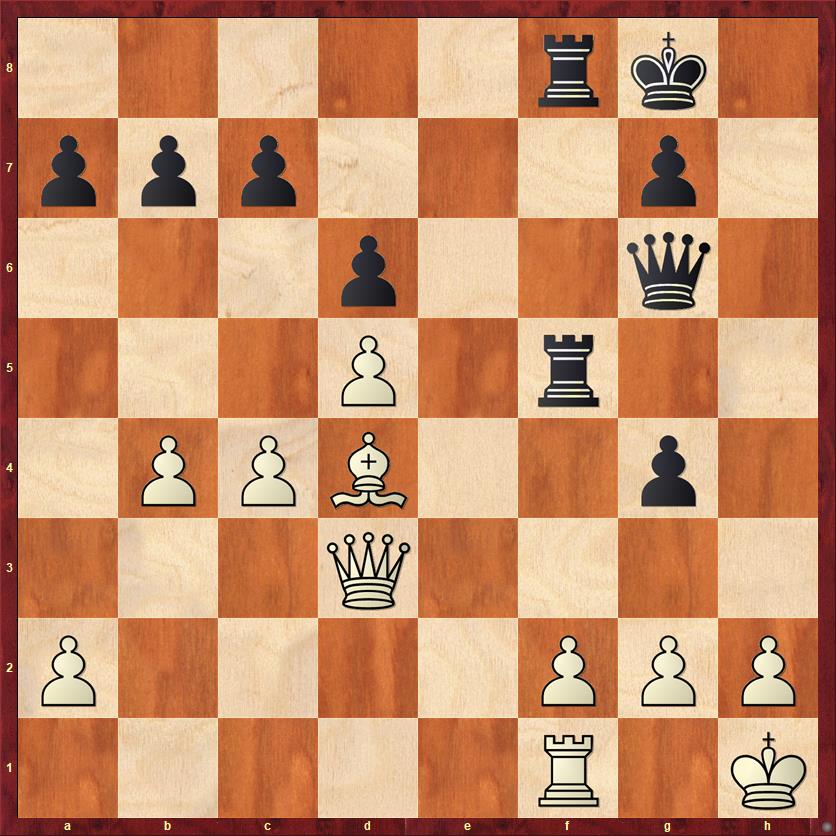
FEN: 5rk1/ppp3p1/3p2q1/3P1r2/1PPB2p1/3Q4/P4PPP/5R1K b – – 0 24
Another position where I have bitter regrets. Once again I fell into the trap of obsessing over a move that doesn’t work. The move I so badly wanted to play was 23. … Rxf2?, discovering an attack on White’s queen and threatening a back-rank mate. Except… it’s not mate! After 24. Qxg6 Rxf1+ 25. Bg1 Re1 26. Qxg4 R8f1 27. Qd4 Black has nothing better than a draw by chasing White’s queen forever on the g1-a7 diagonal.
I tried so hard to make this work. I burned more minutes on it, to no avail. And my tunnel vision cost me another opportunity. Once again, I could have played 23. … g3!, the same move I overlooked before. After 24. Qxg3 Rg5 25. Qh3 Black has the cute move 25. … Rg4!, which prevents Qe6+ and also skewers the bishop and pawn on the fourth rank. Notice that 26. Rd1 doesn’t work because of 26. … Rxd4! 27. Rxd4 Qb1 mate. This time, it really is a back-rank mate. So the bishop has to move, and just as before, the loose c4 pawn is a casualty. Loose pieces (and pawns) drop off!
24. … Qh7
The idea behind this move was to put my queen on a defended square so that I can move my f5 rook. Also, I still had some hopes of attacking on the h-file. Since there is some sort of plan behind this move, I can’t criticize it too much.
25. Re1 Rh5?
The wrong way. Playing through this part of the game is so painful. Black’s pieces voluntarily go to worse and worse squares, while White’s pieces find better and better squares.
The computer’s recommendation for Black is 24. … Rf4! From the strategic point of view, I totally misunderstood this position. As we’ve seen several times already, Black’s true advantage now lies in attacking the poorly defended bishop and c-pawn, not in the failed dreams of breaking through on the h-file. And also Black has the ongoing threat of … g4-g3, a threat that I was unaccountably blind to. Basically, what makes 24. … Rf4 strong is that White’s queen cannot simultaneously defend the bishop and the g3 square. So, for instance, 25. Qc3 would be met by 25. … g3. If 25. Qd1 (which indirectly prevents … g3 by protecting the back rank), the computer recommends 25. … Re4. Nothing complicated about this. Black is just fighting for the center and for better squares for his pieces.
Not only did I misunderstand the position, I was now in time trouble with a long way to go until the time control (move 40). That explains to some extent why I crumbled so badly in the last part of the game.
26. Qg3 …
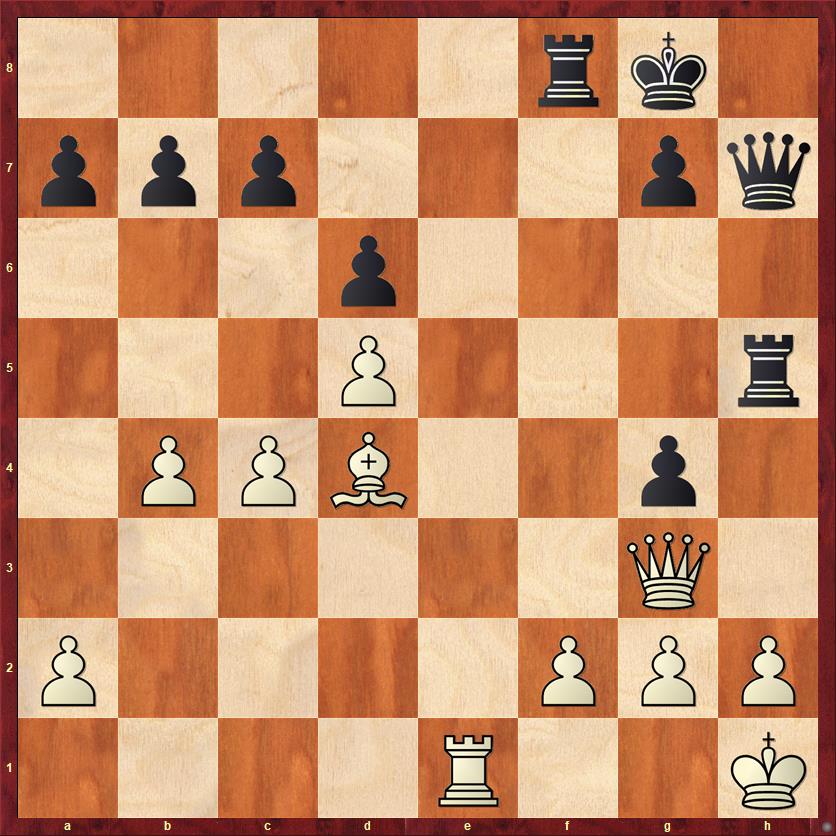
FEN: 5rk1/ppp3pq/3p4/3P3r/1PPB2p1/6Q1/P4PPP/4R2K b – – 0 26
Because this is the last position in the game where Black has a definite advantage, it’s a good position to talk about. We’ve already seen that I was not up to the task of finding extraordinary tactics in this game. I missed all the ideas involved with … g4-g3. But what we have now is not an extraordinary position. It’s a very ordinary position, where I have a slight material advantage. My goals should be to take away White’s counterplay and try to reach a superior endgame.
How should I have thought about this position? Let’s start with the threats. White is not at the moment threatening 27. Qxg4 because … Rxh2+ is a strong reply. However, this pawn is vulnerable and I should think about defending it in the near future. Also, White is not at the moment threatening 27. Re7, because of the back-rank mate with … Qb1+. However, the rook invasion is a significant threat in the future. So what we see is that Black does not have any immediate threats to deal with but there are some on the horizon. In essence, the chess gods have given me the gift of one tempo for prophylaxis, and I should take advantage of it.
What about my threats? Well, if I could somehow move my rook to h8 without exposing my king to attack, I would simply be winning. But there doesn’t seem to be any way to do that. 26. … Kf7 would be immediately met by 27. Qf4+. Black wants to minimize risk in this position, not maximize it!
Where should my pieces be? If I could arrange to have Alekhine’s gun on the h-file, that would be great, but I don’t see a way to do it. Failing that, we have to admit that my pieces are pretty badly placed. The queen is hiding away on h7, where she can’t really exercise her royal powers. The rook is awkwardly placed on h5. Both of these pieces need more sensible places to be. The queen should be centralized. The rook may need to be re-routed to h7 after the queen leaves, so that it can either defend g7 or (after … g7-g6 or … g7-g5) defend the seventh rank.
What trades would I like to make? Any of them! A queen trade would be good; for example, … Qh7-f5-f4 comes to mind, perhaps prepared first with … g5. A rook trade would be even better, because right now White’s rook is his best piece. Also, in general, exchange-up endgames become easier to win after a pair of rooks are traded.
Putting all of these ingredients together, we’re starting to form a semblance of a plan. A really good starting point is 26. … Qf5. This accomplishes lots of good things. It defends the pawn on g4. It centralizes the queen. It vacates the square h7 for my rook. It takes the first step toward a possible plan of … Rh7, … g5, and … Qf4. One concern about it is that it leaves the g7-pawn undefended, so White might be able to play 27. f3, but 27. … Qf4 shuts down White’s counterplay before it gets started. Or White could try 27. Qc3, but then we have a couple of possibilities. One is to get the queens off the board with 27. … Qf4 28. g3 Qf3+. This gets to an endgame that is definitely better and probably winning. Alternatively, on 27. Qc3 I could continue my plan with 27. … Rh7. This looks a bit scary because White could play 28. Re7, but then Black has the excellent resource 28. … Qh5! 29. Qg3 (forced) Re8, which achieves the goal of trading rooks. This is actually a great step forward for Black, because White’s rook was probably his most dangerous piece.
What we can see from this analysis is that the tactics are not yet exhausted in this game, but they come after the strategy.
In particular, it’s interesting to see how Black uses the pressure on the h-file. I’m not attempting to win the game by tripling on the h-file. That would be caveman chess, and besides, it doesn’t work because it gets my king into trouble. Instead I’m using that pressure to keep White’s queen from getting too active. If she moves away to c3, a timely … Qh5 forces her back.
Remember, the threat is stronger than the execution. I’m never actually going to take that h2 pawn. I’m just going to keep White worried about it.
Instead I played a very panicky move:
26. … g6?
Ugh. Groan. Clearly I was very worried about Re7, but remember, that wasn’t even a threat yet. The best thing about the queen’s position on h7 was the way it kept pressure on the b1-h7 diagonal. Now I have taken away the queen’s only aggressive line and turned her into a completely defensive piece. I’ve blocked her from coming to f5. It will also be really hard now to defend the g4 pawn, so as a result of this bad move I also end up putting my rook in an even worse place, h4.
It might be interesting to write a post or an essay sometime on the question: Should I move a pawn or a piece? This position would be Exhibit A. My problems are due to poorly placed pieces. A pawn move does not cure that problem.
According to the computer, my advantage has now dropped to 0.00.
27. Kg1 …
A nice practical move by Tate. If … Rxh2 happens, he doesn’t want it to be check.
27. … Rh4?
Ugh ugh ugh. The rook is now enslaved to defend a mere pawn. Better to sacrifice the pawn than to settle for such a fate. The computer recommends 27. … Qh6 (still aiming for the f4 square) 28. Qxg4 Rxh2 (see why it was important for Tate to move his king away prophylactically?) 29. Qe6+ Rf7 30. Qc8+ Rf8 31. Qe6+, with a draw by repetition.
28. c5 …
Amazingly, the queenside pawn march that Tate launched with 16. b4, and then put on hold for the last 12 moves, has finally been put into action.
28. … dc?!
I’m starting to get tired of putting a question mark next to every Black move. The position was already getting very difficult for me. Still, the computer says that Black would still be holding on after 28. … g5. Now my position starts circling the drain more and more rapidly.
One problem with criticizing all of my moves is that I haven’t said enough complimentary things about Tate’s play. Although his treatment of the opening and early middlegame left a lot to be desired, he fought back well from a very dicey position, and after he got the advantage he took advantage of it swiftly and efficiently.
29. Bxc5 Rd8 30. Bd4! Rh5
Trying to re-activate the rook.
31. d6! …
A cute idea. If you have a weak pawn, sometimes the best thing to do with it is give it away, in order to saddle your opponent with a weak pawn. If 31. … cd, Black’s incipient activity on the d-file would be shut down. Instead I tried to keep the file open, but then I got annihilated on the back rank.
31. … Rxd6? 32. Re8+ Kf7 33. Qe3 g5 34. Re7+ Kg6 35. Qe4+ Black resigns
An exasperating game to be sure, but these are the kinds of games that we can learn the most from. I have a long list of lessons from this one!
- Don’t get intimidated by your opponent’s rating, and don’t let it alter your play. (Black move 7.)
- In particular, don’t feel as if you have to make “weird” moves to throw him off his stride. (Black move 11.)
- Tactics follow strategy, not vice versa! (White move 13, Black move 26.)
- Doubled pawns, even when they are isolated, are not necessarily a weakness. They usually give you an extra open file or half-open file, which you may be able to use to your advantage. (Black move 19.)
- When you’re building an attack, resist the urge to strike too soon. Look for flexible moves, and invite all of your pieces to the party. (Black moves 20, 21.)
- When you’re attacking, breadth of vision is very important. Watch out for “tunnel vision.” The more winning ideas you have, the more likely it is that your attack will succeed. The most ferocious attacks are the ones that force the opponent to parry many threats at once. (Black moves 20-24.)
- Not many of us can be as brilliant as Marshall, or Tal, or Kasparov… But sometimes you can copy them! (Black move 22.)
- When you’re defending, a timely material sacrifice can do wonders to change the momentum of the game. Often your opponent will have trouble adjusting to a position where he no longer has the initiative. (White move 23.)
- If your problem is poorly placed pieces, you won’t solve that problem by moving a pawn. (Black move 26.)
- You can’t play a move if you never even look at it. I can almost guarantee you that at least once every game, there is a move you’re not even looking at because you think it’s “impossible.” The road to mastery is to expand your concept of the possible. (Black move 22.)



{ 2 comments… read them below or add one }
awesome commentary
Wow, what a great position after move 20. There was a lot of material here that people can learn from, both on how to attack and on how to defend. This game deserves deeper study. I have a few comments I’d like to add.
You wrote:
“This was a case of the Mike Splane Question gone wrong: I was convinced that I was going to sacrifice the knight and win with a checkmate on g2, or if he didn’t take the knight, I was going to win with a checkmate on h2. My single-minded obsession with this plan meant that I was blind to other plans.”
Point #1, this game was played long before you had heard of the Mike Splane question, so you were not using it in his game.
Point #2 The answer to the Mike Splane question is never expressed in concrete moves. That’s tactics. You’re confusing tactical analysis with a general plan. This game was very typical of your play in those days, making all of your decisions on brute force calculations of forcing moves. Answering the Mike Splane question gives you a general idea of what you want to achieve, not how to achieve it.
Point #3 Your Raf8 move was incredibly bad. What does the rook accomplish on f8? Nothing. You just completely wasted a tempo on a move that does nothing to address the problems with your position. What are those problems? Pieces that can’t move or are restricted in scope by your own pawns are bad pieces. What is your queen doing on g6? Nothing. How many squares can your knight move to? None.
How would Mr. Tate answer the Mike Splane question? He would say something like ‘I’ll trade my bishop for his knight and then win the heavy piece ending by exploiting all of his weak pawns and my safer king.” If you understand what Tate wants to do, you can easily predict his next move will be Bd4. You have to be prepared to meet that move by creating a safe but active retreat square for your knight RIGHT NOW. That means either moving the queen or pushing the g pawn, or finding a way to make the Nf3 move work.
In principle the idea of bringing all of your pieces to the party is correct. But where does the a8 rook want to be? Do you have an attack down the f file? No. the f2-pawn is overprotected. The rooks belong on the h file – the h2 square is the weakest point in White’s position. So … Kf7 might also be a good candidate move, preparing Rah8.
Point #4 You wrote
“My single-minded obsession with this plan meant that I was blind to other plans. This is another one of my bad habits in chess, which Mike has pointed out on numerous occasions: tunnel vision.”
A few years ago we discussed a game I played against Cameron Wheeler. In your blog http://www.danamackenzie.com/blog/?p=982
you wrote this about a critical position it that game:
“Here I would be looking at all sorts of exchange sacrifices, on f2 or g3, and they might even work, but Mike has a different philosophy. Instead of giving away your material, why don’t you just wait for your opponent to give you his?”
I still recall our conversation. You suggested a couple of sacrifices and I jokingly replied “I like to sacrifice my opponent’ pieces.” Then we both laughed. Since then I have noticed on several occasions that if you see a way to sacrifice a piece you will focus on analyzing it while ignoring other candidates moves.
Other Points:
You never mentioned the need to force White to weaken the pawn structure in front of his king. Along with the Nf3 idea you should have also been considering Rf3, or g4-g3, or doubling heavy pieces on the h-file. Once you break up his pawn cover all sorts of tactical opportunities will become available.
In my upcoming book I have a section that discusses exchange sacrifices as a common defensive idea. You feel right into his hands with Nd3.